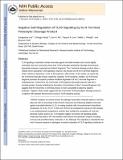| dc.contributor.author | Ploegh, Hidde | |
| dc.contributor.author | Lee, Sungwook | |
| dc.contributor.author | Kang, Dongju | |
| dc.contributor.author | Ra, Eun A. | |
| dc.contributor.author | Lee, Taeyun A. | |
| dc.contributor.author | Park, Boyoun | |
| dc.date.accessioned | 2015-04-22T16:06:56Z | |
| dc.date.available | 2015-04-22T16:06:56Z | |
| dc.date.issued | 2014-09 | |
| dc.date.submitted | 2014-01 | |
| dc.identifier.issn | 0022-1767 | |
| dc.identifier.issn | 1550-6606 | |
| dc.identifier.uri | http://hdl.handle.net/1721.1/96698 | |
| dc.description.abstract | TLR signaling is essential to innate immunity against microbial invaders and must be tightly controlled. We have previously shown that TLR9 undergoes proteolytic cleavage processing by lysosomal proteases to generate two distinct fragments. The C-terminal cleavage product plays a critical role in activating TLR9 signaling; however, the precise role of the N-terminal fragment, which remains in lysosomes, in the TLR9 response is still unclear. In this article, we report that the N-terminal cleavage product negatively regulates TLR9 signaling. Notably, the N-terminal fragment promotes the aspartic protease-mediated degradation of the C-terminal fragment in endolysosomes. Furthermore, the N-terminal TLR9 fragment physically interacts with the C-terminal product, thereby inhibiting the formation of homodimers of the C-terminal fragment; this suggests that the monomeric C-terminal product is more susceptible to attack by aspartic proteases. Together, these results suggest that the N-terminal TLR9 proteolytic cleavage product is a negative self-regulator that prevents excessive TLR9 signaling activity. | en_US |
| dc.description.sponsorship | Korea (South). Ministry of Education, Science and Technology (MEST) (National Research Foundation of Korea. Grant 2011-0015372) | en_US |
| dc.description.sponsorship | Korea (South). Ministry of Education, Science and Technology (MEST) (National Research Foundation of Korea. Grant 2010-0009203) | en_US |
| dc.description.sponsorship | Korea. Ministry of Health and Welfare. National Research and Development Program for Cancer Control | en_US |
| dc.language.iso | en_US | |
| dc.publisher | American Association of Immunologists | en_US |
| dc.relation.isversionof | http://dx.doi.org/10.4049/jimmunol.1400210 | en_US |
| dc.rights | Creative Commons Attribution-Noncommercial-Share Alike | en_US |
| dc.rights.uri | http://creativecommons.org/licenses/by-nc-sa/4.0/ | en_US |
| dc.source | PMC | en_US |
| dc.title | Negative Self-Regulation of TLR9 Signaling by Its N-Terminal Proteolytic Cleavage Product | en_US |
| dc.type | Article | en_US |
| dc.identifier.citation | Lee, S., D. Kang, E. A. Ra, T. A. Lee, H. L. Ploegh, and B. Park. “Negative Self-Regulation of TLR9 Signaling by Its N-Terminal Proteolytic Cleavage Product.” The Journal of Immunology 193, no. 7 (September 3, 2014): 3726–3735. | en_US |
| dc.contributor.department | Massachusetts Institute of Technology. Department of Biology | en_US |
| dc.contributor.department | Whitehead Institute for Biomedical Research | en_US |
| dc.contributor.mitauthor | Ploegh, Hidde | en_US |
| dc.relation.journal | Journal of Immunology | en_US |
| dc.eprint.version | Author's final manuscript | en_US |
| dc.type.uri | http://purl.org/eprint/type/JournalArticle | en_US |
| eprint.status | http://purl.org/eprint/status/PeerReviewed | en_US |
| dspace.orderedauthors | Lee, S.; Kang, D.; Ra, E. A.; Lee, T. A.; Ploegh, H. L.; Park, B. | en_US |
| dc.identifier.orcid | https://orcid.org/0000-0002-1090-6071 | |
| mit.license | OPEN_ACCESS_POLICY | en_US |
| mit.metadata.status | Complete | |
